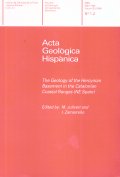Geología de los materiales Paleozoicos de las Escamas de la Cordillera prelitoral catalana al Este del río Llobregat
Abstract
Paleozoic rocks crop out in a narrow belt along the southeastern border of the Ebro basin, between the Anoia and the Congost rivers. These rocks override the Paleogene beds of the basin, and in the sector between the Llobregat river and Caldes de Montbui they form three slices overriding each other. The stratigraphic sequence is best shown in the Pedritxes slice (the rniddle and the largest). It consists of slates and greywackes with sedimentary structures peculiar of the turbidites. Acid volcanic rocks occur, specially in the lower part of the sequence, where a rnassive horizon, 150-200 m thick, is found. The volcanic rocks consist of different types of ignirnbrites and tuffs. The sequence is older than the Silurian and can be probably assigned to the Llandeilo-Caradoc, by comparison with the Guilleries massif, but no paleontological evidence is available. All paleozoic rocks have been affected by a regional rnetamorphisrn. In addition, late granitoids have induced a contact rnetamorphisrn. Most of the area shows greenschist-facies conditions, but locally the sillimanite zone is reached. The low-grade areas show a slaty cleavage as dominant foliation. In high-grade areas there is a schistosity which in sorne cases is a crenulation. This coupled with the presence of intrafolial folds point towards the existence of two superimposed deformations. Both, the low- and high-grade areas were later inhornogeneously affected by a late crenulation cleavage, chevron folds and kink bands. All hercynian structures have at a certain degree been rnodified by the alpine overprinting, responsible of the thrusting.


